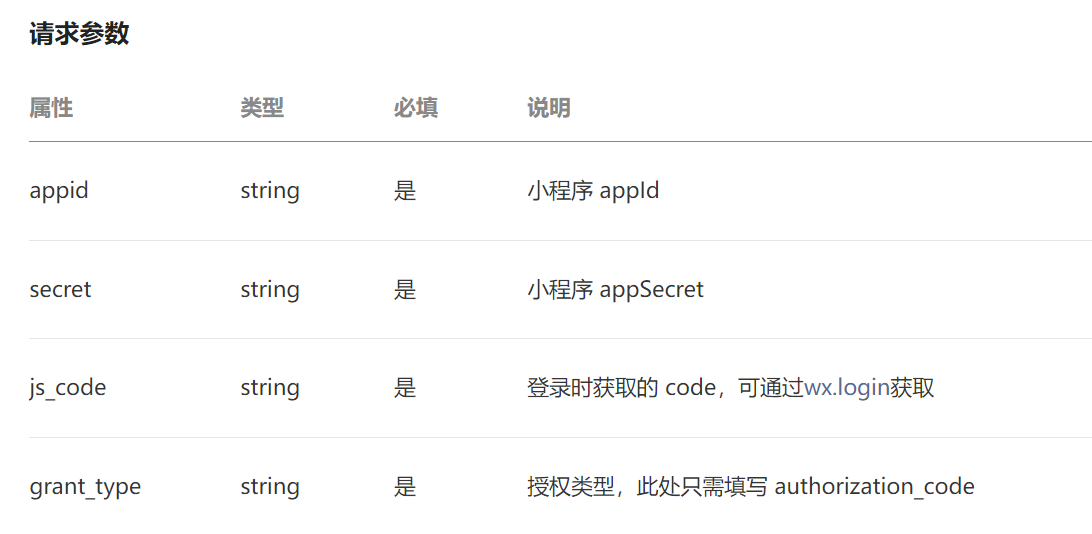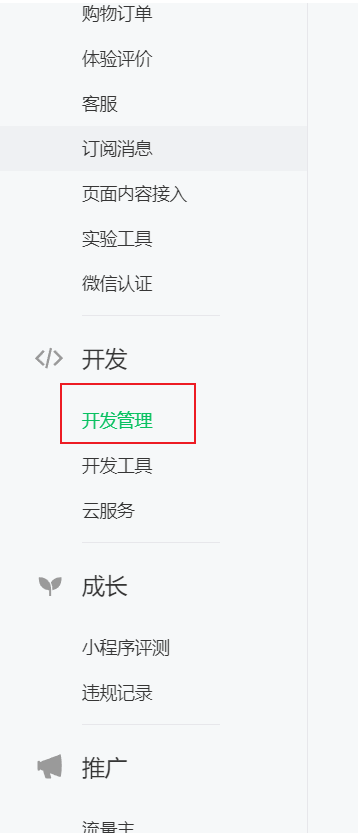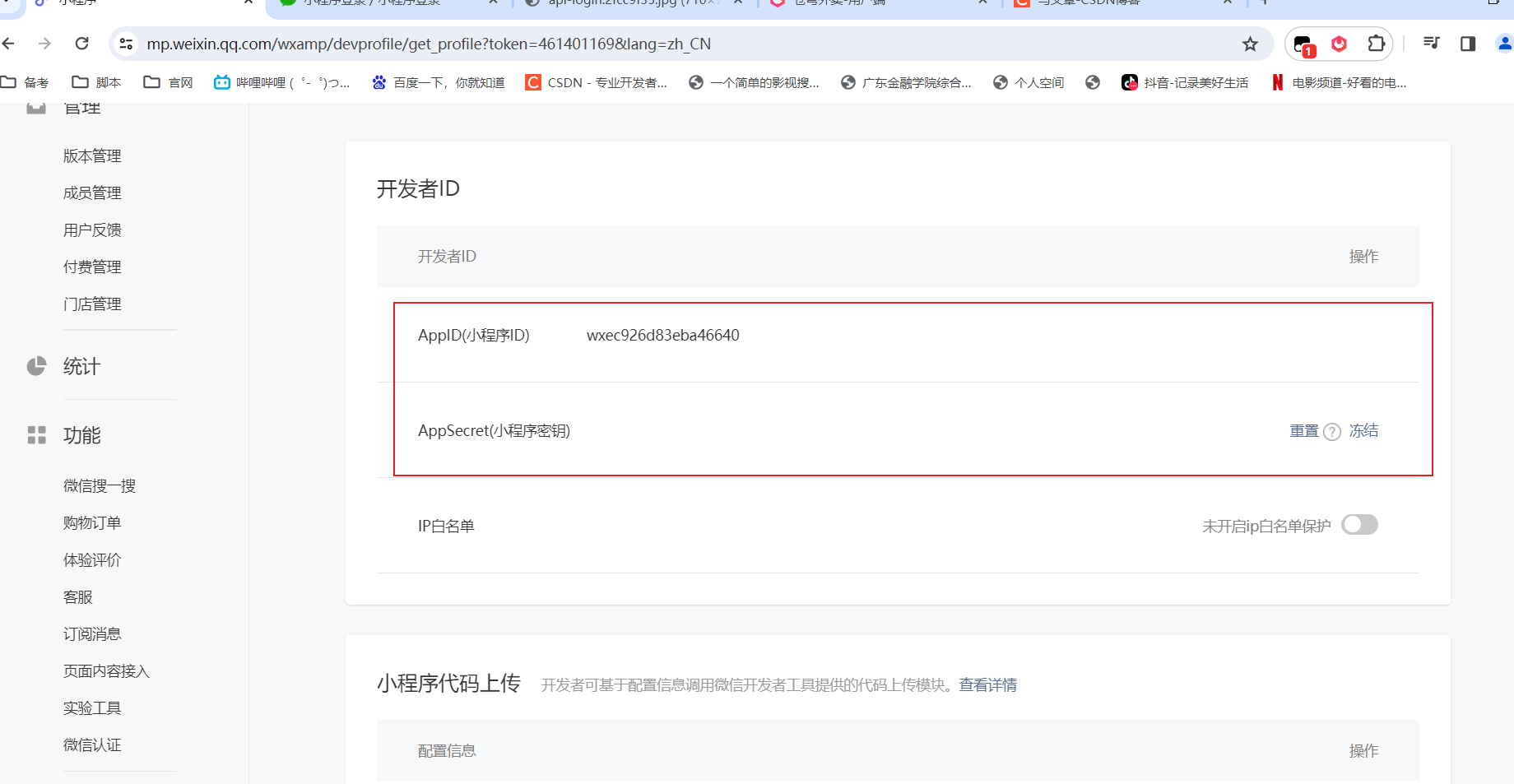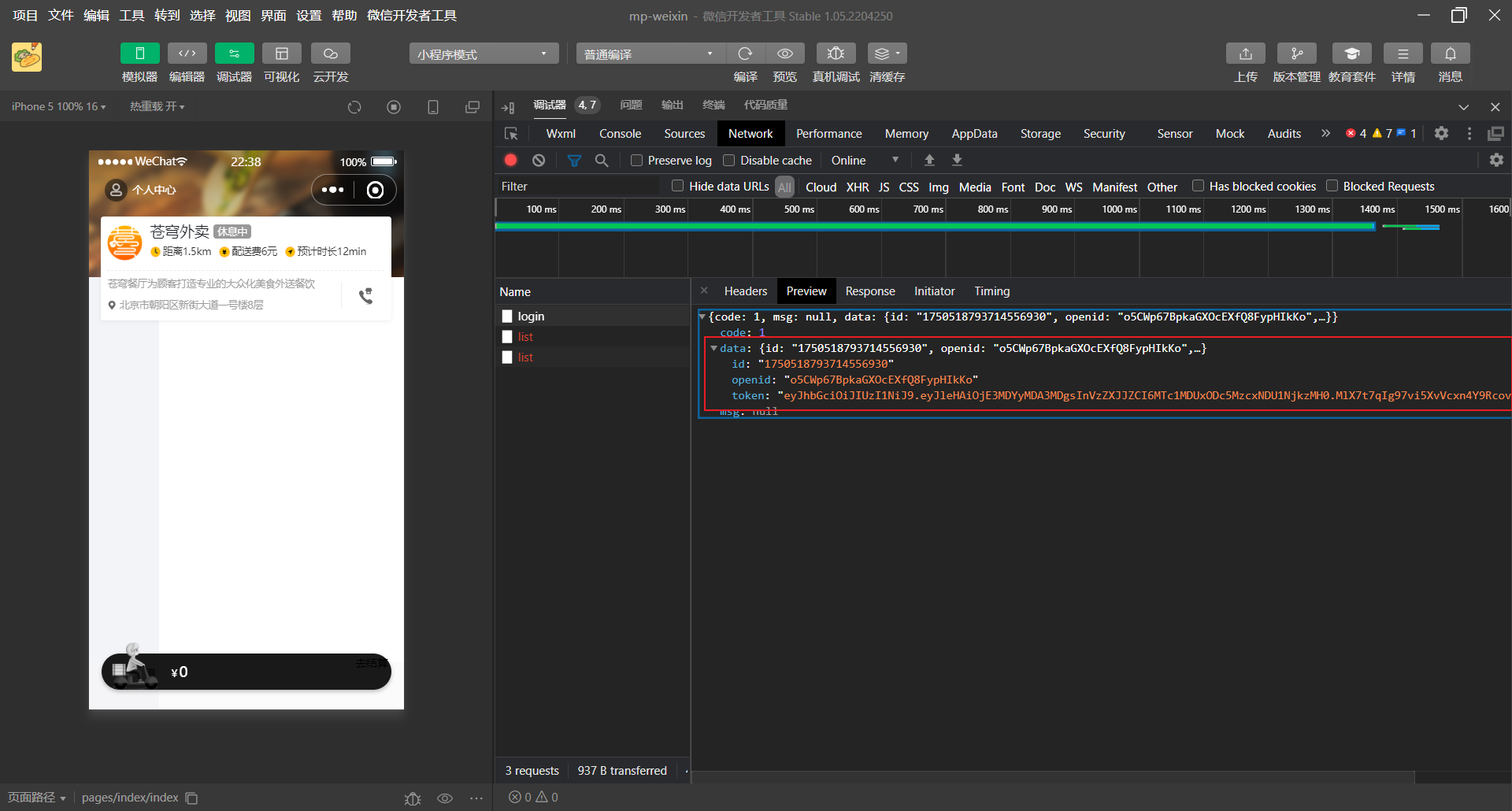- 1前端进阶全栈入门级教程nodeJs博客开发(一)搭建环境与路由_const port = 8000 const serverhandle = require('..
- 2远程连接linux系统提示“远程系统拒绝连接“_linux远程连接被拒绝
- 3GPU并行计算基础知识科普_gpu并行计算原理
- 4android js交互_HarmonyOS对Android开发者也太友好了吧
- 5程序人生——Java数组和集合使用建议(1)
- 6java中Map List
的用法_定义map - 7HarmonyOS开发48:美化组件:形状美化_鸿蒙开发设置bounds
- 8微服务SpringCloud面试题27问_springcloud和springcloudalibaba的面试题
- 9python局部变量函数_22、Python 函数的局部变量
- 10Vue3 axios请求_vue3请求数据axios
微信小程序~整合springboot_springboot整合微信小程序
赞
踩
微信小程序~整合springboot
登录封装
整合微信小程序.我们得先去看微信小程序的文档
我们先来看登录的流程是什么
登录流程时序

首先,我们小程序要wx.login 获取code,这个code是临时登录凭证code,一次只能用一次
,这个是前端的代码,我这里也就不赘述了,其实很简单的,就是调用这个方法wx.login(),
然后带着这个code发送到我们后端的服务器,再后端服务器中,我们要像微信的接口api发送请求,获得session_id + openid
比较重要的就是这个openid,openid是用户的唯一标识,反而这个session_id不太中重要,因为我们这里用到是token,返回请求之后,我们要生成token返回给前端,前端其他的请求要发过来的化,就要带着这个token
整体的逻辑很简单,前端给到后端,code,后端带着这个code去请求wx的api,返回用户的唯一id,openid,然后,我们得到openid之后,生成token,最后返回给前端
wx 登录api
然后是这里的向微信发送的api的情况



我们来看这里的几个请求参数
我们先来看,已经有的,这里的js_code 就是我们从前端得到的code,;临时登录凭证
然后第四个参数是grant_type是固定参数 authorization_code
然后有两个参数分别是appid,secret这个我们得再小程序里边拿到
位置再如下


这两个东西都在这里
代码准备工作
httpClient的封装
第一,因为涉及到了要发请求,我们得有发请求的组件,我这里用到的是httpClient,我另外也写了一个httpClient的封装,另外,我另外一个博客也有写,可以去看,我这里就贴出来,httpClient的工具类
/** * Http工具类 */ public class HttpClientUtil { static final int TIMEOUT_MSEC = 5 * 1000; /** * 发送GET方式请求 * @param url * @param paramMap * @return */ public static String doGet(String url,Map<String,String> paramMap){ // 创建Httpclient对象 CloseableHttpClient httpClient = HttpClients.createDefault(); String result = ""; CloseableHttpResponse response = null; try{ URIBuilder builder = new URIBuilder(url); //填入参数 if(paramMap != null){ for (String key : paramMap.keySet()) { builder.addParameter(key,paramMap.get(key)); } } URI uri = builder.build(); //创建GET请求 HttpGet httpGet = new HttpGet(uri); //发送请求 response = httpClient.execute(httpGet); //判断响应状态 if(response.getStatusLine().getStatusCode() == 200){ result = EntityUtils.toString(response.getEntity(),"UTF-8"); } }catch (Exception e){ e.printStackTrace(); }finally { try { response.close(); httpClient.close(); } catch (IOException e) { e.printStackTrace(); } } return result; } /** * 发送POST方式请求 * @param url * @param paramMap * @return * @throws IOException */ public static String doPost(String url, Map<String, String> paramMap) throws IOException { // 创建Httpclient对象 CloseableHttpClient httpClient = HttpClients.createDefault(); CloseableHttpResponse response = null; String resultString = ""; try { // 创建Http Post请求 HttpPost httpPost = new HttpPost(url); // 创建参数列表 if (paramMap != null) { List<NameValuePair> paramList = new ArrayList(); for (Map.Entry<String, String> param : paramMap.entrySet()) { paramList.add(new BasicNameValuePair(param.getKey(), param.getValue())); } // 模拟表单 UrlEncodedFormEntity entity = new UrlEncodedFormEntity(paramList); httpPost.setEntity(entity); } httpPost.setConfig(builderRequestConfig()); // 执行http请求 response = httpClient.execute(httpPost); resultString = EntityUtils.toString(response.getEntity(), "UTF-8"); } catch (Exception e) { throw e; } finally { try { response.close(); } catch (IOException e) { e.printStackTrace(); } } return resultString; } /** * 发送POST方式请求 * @param url * @param paramMap * @return * @throws IOException */ public static String doPost4Json(String url, Map<String, String> paramMap) throws IOException { // 创建Httpclient对象 CloseableHttpClient httpClient = HttpClients.createDefault(); CloseableHttpResponse response = null; String resultString = ""; try { // 创建Http Post请求 HttpPost httpPost = new HttpPost(url); if (paramMap != null) { //构造json格式数据 JSONObject jsonObject = new JSONObject(); for (Map.Entry<String, String> param : paramMap.entrySet()) { jsonObject.put(param.getKey(),param.getValue()); } StringEntity entity = new StringEntity(jsonObject.toString(),"utf-8"); //设置请求编码 entity.setContentEncoding("utf-8"); //设置数据类型 entity.setContentType("application/json"); httpPost.setEntity(entity); } httpPost.setConfig(builderRequestConfig()); // 执行http请求 response = httpClient.execute(httpPost); resultString = EntityUtils.toString(response.getEntity(), "UTF-8"); } catch (Exception e) { throw e; } finally { try { response.close(); } catch (IOException e) { e.printStackTrace(); } } return resultString; } private static RequestConfig builderRequestConfig() { return RequestConfig.custom() .setConnectTimeout(TIMEOUT_MSEC) .setConnectionRequestTimeout(TIMEOUT_MSEC) .setSocketTimeout(TIMEOUT_MSEC).build(); } }
- 1
- 2
- 3
- 4
- 5
- 6
- 7
- 8
- 9
- 10
- 11
- 12
- 13
- 14
- 15
- 16
- 17
- 18
- 19
- 20
- 21
- 22
- 23
- 24
- 25
- 26
- 27
- 28
- 29
- 30
- 31
- 32
- 33
- 34
- 35
- 36
- 37
- 38
- 39
- 40
- 41
- 42
- 43
- 44
- 45
- 46
- 47
- 48
- 49
- 50
- 51
- 52
- 53
- 54
- 55
- 56
- 57
- 58
- 59
- 60
- 61
- 62
- 63
- 64
- 65
- 66
- 67
- 68
- 69
- 70
- 71
- 72
- 73
- 74
- 75
- 76
- 77
- 78
- 79
- 80
- 81
- 82
- 83
- 84
- 85
- 86
- 87
- 88
- 89
- 90
- 91
- 92
- 93
- 94
- 95
- 96
- 97
- 98
- 99
- 100
- 101
- 102
- 103
- 104
- 105
- 106
- 107
- 108
- 109
- 110
- 111
- 112
- 113
- 114
- 115
- 116
- 117
- 118
- 119
- 120
- 121
- 122
- 123
- 124
- 125
- 126
- 127
- 128
- 129
- 130
- 131
- 132
- 133
- 134
- 135
- 136
- 137
- 138
- 139
- 140
- 141
- 142
- 143
- 144
- 145
- 146
- 147
- 148
- 149
- 150
- 151
- 152
- 153
- 154
- 155
- 156
- 157
- 158
属性的设置
首先是微信相关的属性的设置
@Component @ConfigurationProperties(prefix = "sky.wechat") @Data public class WeChatProperties { private String appid; //小程序的appid private String secret; //小程序的秘钥 private String mchid; //商户号 private String mchSerialNo; //商户API证书的证书序列号 private String privateKeyFilePath; //商户私钥文件 private String apiV3Key; //证书解密的密钥 private String weChatPayCertFilePath; //平台证书 private String notifyUrl; //支付成功的回调地址 private String refundNotifyUrl; //退款成功的回调地址 }
- 1
- 2
- 3
- 4
- 5
- 6
- 7
- 8
- 9
- 10
- 11
- 12
- 13
- 14
- 15
- 16
然后是这里的jwt token相关的属性,我这里因为是后端和小程序端是分开的,所以我这里也得写
@Component @ConfigurationProperties(prefix = "sky.jwt") @Data public class JwtProperties { /** * 管理端员工生成jwt令牌相关配置 */ private String adminSecretKey; private long adminTtl; private String adminTokenName; /** * 用户端微信用户生成jwt令牌相关配置 */ private String userSecretKey; private long userTtl; private String userTokenName; }
- 1
- 2
- 3
- 4
- 5
- 6
- 7
- 8
- 9
- 10
- 11
- 12
- 13
- 14
- 15
- 16
- 17
- 18
- 19
- 20
- 21
分别在yml中进行设置
sky:
jwt:
user-secret-key: itheima
user-ttl: 7200000
user-token-name: authentication
wechat:
appid: ${sky.wechat.appid}
secret: ${sky.wechat.secret}
- 1
- 2
- 3
- 4
- 5
- 6
- 7
- 8
我这里做了一个解耦,这里是主yml,真正的配置我写到了dev.yml中
sky:
wechat:
appid: 自己的appid
secret: 自己的密码
- 1
- 2
- 3
- 4
这里就差不多准备工作做完了
核心代码
/** * @author jjking * @date 2024-01-25 21:10 */ @RestController @RequestMapping("/user/user") @Slf4j @Api(tags = "用户相关") public class UserController { @Autowired private UserService userService; @Autowired private JwtProperties jwtProperties; /** * 微信登录 * @param userLoginDTO * @return */ @PostMapping("/login") @ApiOperation("微信登录") public Result<UserLoginVO> login(@RequestBody UserLoginDTO userLoginDTO) { log.info("微信用户登录: {}",userLoginDTO.getCode()); //获得用户信息 User user = userService.wxLogin(userLoginDTO); //生成jwt令牌 Map<String, Object> claims = new HashMap<>(); claims.put(JwtClaimsConstant.USER_ID,user.getId()); String token = JwtUtil.createJWT(jwtProperties.getUserSecretKey(), jwtProperties.getUserTtl(), claims); UserLoginVO userLoginVO = UserLoginVO.builder() .id(user.getId()) .openid(user.getOpenid()) .token(token) .build(); return Result.success(userLoginVO); } }
- 1
- 2
- 3
- 4
- 5
- 6
- 7
- 8
- 9
- 10
- 11
- 12
- 13
- 14
- 15
- 16
- 17
- 18
- 19
- 20
- 21
- 22
- 23
- 24
- 25
- 26
- 27
- 28
- 29
- 30
- 31
- 32
- 33
- 34
- 35
- 36
- 37
- 38
- 39
- 40
- 41
- 42
- 43
- 44
- 45
这里真正的核心代码在userService.wxLogin(userLoginDTO);里边,我们这里外边就是获得openid,然后生成jwt token
这里的jwt Util这里我也贴出来
public class JwtUtil { /** * 生成jwt * 使用Hs256算法, 私匙使用固定秘钥 * * @param secretKey jwt秘钥 * @param ttlMillis jwt过期时间(毫秒) * @param claims 设置的信息 * @return */ public static String createJWT(String secretKey, long ttlMillis, Map<String, Object> claims) { // 指定签名的时候使用的签名算法,也就是header那部分 SignatureAlgorithm signatureAlgorithm = SignatureAlgorithm.HS256; // 生成JWT的时间 long expMillis = System.currentTimeMillis() + ttlMillis; Date exp = new Date(expMillis); // 设置jwt的body JwtBuilder builder = Jwts.builder() // 如果有私有声明,一定要先设置这个自己创建的私有的声明,这个是给builder的claim赋值,一旦写在标准的声明赋值之后,就是覆盖了那些标准的声明的 .setClaims(claims) // 设置签名使用的签名算法和签名使用的秘钥 .signWith(signatureAlgorithm, secretKey.getBytes(StandardCharsets.UTF_8)) // 设置过期时间 .setExpiration(exp); return builder.compact(); } /** * Token解密 * * @param secretKey jwt秘钥 此秘钥一定要保留好在服务端, 不能暴露出去, 否则sign就可以被伪造, 如果对接多个客户端建议改造成多个 * @param token 加密后的token * @return */ public static Claims parseJWT(String secretKey, String token) { // 得到DefaultJwtParser Claims claims = Jwts.parser() // 设置签名的秘钥 .setSigningKey(secretKey.getBytes(StandardCharsets.UTF_8)) // 设置需要解析的jwt .parseClaimsJws(token).getBody(); return claims; } }
- 1
- 2
- 3
- 4
- 5
- 6
- 7
- 8
- 9
- 10
- 11
- 12
- 13
- 14
- 15
- 16
- 17
- 18
- 19
- 20
- 21
- 22
- 23
- 24
- 25
- 26
- 27
- 28
- 29
- 30
- 31
- 32
- 33
- 34
- 35
- 36
- 37
- 38
- 39
- 40
- 41
- 42
- 43
- 44
- 45
- 46
- 47
- 48
- 49
最核心的代码
我门在service中的写的这个方法就是最核心的代码
/** * 用户信息(User)表服务实现类 * * @author makejava * @since 2024-01-25 21:06:35 */ @Service("userService") public class UserServiceImpl extends ServiceImpl<UserMapper, User> implements UserService { @Override public User wxLogin(UserLoginDTO userLoginDTO) { String openid = getOpenId(userLoginDTO.getCode()); //如果返回的是空,说明没有这个用固话,表示登录失败,抛出业务异常 if(StrUtil.isBlankOrUndefined(openid)) { //返回登录失败 throw new LoginFailedException(MessageConstant.LOGIN_FAILED); } //查数据库,中是否有这个用户 LambdaQueryWrapper<User> wrapper = new LambdaQueryWrapper<>(); wrapper.eq(User::getOpenid,openid); User user = getOne(wrapper); //如果当前用户是新用户,那么就要存入进入 if(Objects.isNull(user)) { user = User.builder().openid(openid).build(); save(user); } //如果不是直接返回 return user; } //wx登录api public static final String WX_LOGIN = "https://api.weixin.qq.com/sns/jscode2session"; @Autowired private WeChatProperties weChatProperties; public String getOpenId(String code) { Map<String, String> paramMap = new HashMap<>(); paramMap.put("appid",weChatProperties.getAppid()); paramMap.put("secret",weChatProperties.getSecret()); paramMap.put("js_code",code); paramMap.put("grant_type","authorization_code"); //发送请求 String json = HttpClientUtil.doGet(WX_LOGIN, paramMap); //解码json数据 JSONObject jsonObject = JSON.parseObject(json); String openid = jsonObject.getString("openid"); return openid; } }
- 1
- 2
- 3
- 4
- 5
- 6
- 7
- 8
- 9
- 10
- 11
- 12
- 13
- 14
- 15
- 16
- 17
- 18
- 19
- 20
- 21
- 22
- 23
- 24
- 25
- 26
- 27
- 28
- 29
- 30
- 31
- 32
- 33
- 34
- 35
- 36
- 37
- 38
- 39
- 40
- 41
- 42
- 43
- 44
- 45
- 46
- 47
- 48
- 49
- 50
- 51
- 52
- 53
- 54
- 55
拦截器设置
/** * jwt令牌校验的拦截器 */ @Component @Slf4j public class JwtTokenUserInterceptor implements HandlerInterceptor { @Autowired private JwtProperties jwtProperties; /** * 校验jwt * * @param request * @param response * @param handler * @return * @throws Exception */ public boolean preHandle(HttpServletRequest request, HttpServletResponse response, Object handler) throws Exception { //判断当前拦截到的是Controller的方法还是其他资源 if (!(handler instanceof HandlerMethod)) { //当前拦截到的不是动态方法,直接放行 return true; } //1、从请求头中获取令牌 String token = request.getHeader(jwtProperties.getUserTokenName()); //2、校验令牌 try { log.info("jwt校验:{}", token); Claims claims = JwtUtil.parseJWT(jwtProperties.getUserSecretKey(), token); Long userId = Long.valueOf(claims.get(JwtClaimsConstant.USER_ID).toString()); log.info("当前用户id:", userId); //设置当前用户id,到ThreadLocal中 BaseContext.setCurrentId(userId); //3、通过,放行 return true; } catch (Exception ex) { //4、不通过,响应401状态码 response.setStatus(401); return false; } } }
- 1
- 2
- 3
- 4
- 5
- 6
- 7
- 8
- 9
- 10
- 11
- 12
- 13
- 14
- 15
- 16
- 17
- 18
- 19
- 20
- 21
- 22
- 23
- 24
- 25
- 26
- 27
- 28
- 29
- 30
- 31
- 32
- 33
- 34
- 35
- 36
- 37
- 38
- 39
- 40
- 41
- 42
- 43
- 44
- 45
- 46
- 47
- 48
我们一定得写这个拦截器,要实现校验jwt的功能,
写了这个配置类,我们还得把它写道mvc的配置里边
/** * 注册自定义拦截器 * * @param registry */ protected void addInterceptors(InterceptorRegistry registry) { log.info("开始注册自定义拦截器..."); //添加后端蓝机器 registry.addInterceptor(jwtTokenAdminInterceptor) .addPathPatterns("/admin/**") .excludePathPatterns("/admin/employee/login"); //添加用户拦截器 registry.addInterceptor(jwtTokenUserInterceptor) .addPathPatterns("/user/**") .excludePathPatterns("/user/user/login") .excludePathPatterns("/user/shop/status"); }
- 1
- 2
- 3
- 4
- 5
- 6
- 7
- 8
- 9
- 10
- 11
- 12
- 13
- 14
- 15
- 16
- 17
- 18
这里的代码就是我刚刚说的流程差不多
测试

最后我们能得到token就没问题



